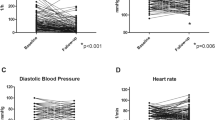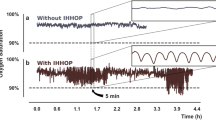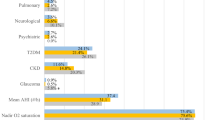Abstract
This study evaluated arterial oxygen saturation (SaO2) over time in a randomly selected group of quadriplegic patients to assess whether clinical history prospectively correlated with profiles of oxygen saturation. In 16 stable male quadriplegic patients (C4-T5), we used pulse oximetry to measure SaO2 over a 24 hour period. Measured values of SaO2 were formatted into a cumulative frequency distribution of SaO2 over time. The cumulative SaO2 values from the quadriplegic patients were compared to SaO2 values in a control group of 12 age-matched healthy male subjects. Ten quadriplegic patients had SaO2 profiles comparable to the range observed in healthy subjects. Six quadriplegic patients had SaO2 profiles outside of the normative range. These 6 exhibited cyclic desaturations (>4%) during periods of behaviorally-defined sleep, suggestive of sleep-disordered breathing. During wakefulness, however, their values of SaO2 were within the normative range. With respect to level of injury, age, time after injury, or medication use, there was no difference between the six 'hypoxic' quadriplegic patients and the 10 'normoxic' quadriplegic patients. Five of the 6 hypoxic patients had a positive medical history of snoring and increased daytime sleepiness, as compared to 6 of 10 normoxic patients who gave a similar history. We also performed Polysomnographic studies in a subgroup of 7 quadriplegic patients. In this subgroup, sleep-disordered breathing was observed in 3 patients (AHI of 54/53/12 per hour, respectively). We conclude that in quadriplegic patients, in whom there is a low clinical suspicion for sleep-disordered breathing, there can occur significant decreases in SaO2 over time.
Similar content being viewed by others
Log in or create a free account to read this content
Gain free access to this article, as well as selected content from this journal and more on nature.com
or
References
Bergofsky E H (1964) Mechanisms for respiratory insufficiency after cervical cord injury. Ann Intern Med 61: 435–447.
Bonekat H W, Andersen G, Squires J (1990) Obstructive disordered breathing during sleep in patients with spinal cord injury. Paraplegia 28: 392–398.
Decker M J, Hoekje P L, Strohl K P (1989) Ambulatory monitoring of arterial oxygen saturation. Chest 95: 717–722.
Slutsky A S, Strohl K P (1980) Quantification of oxygenation during episodic hypoxemia. Am Rev Respir Dis 121: 893–895.
Rechtschaffen A, Kales A (1968) A manual of standardized terminology, techniques and scoring system for sleep stages for human subjects. National Institute of Health publication number 204. Department of Health and Human Services, Washington.
Wynne J W, Block A J, Hemenway J, Hunt L A, Flick M R (1979) Disordered breathing and oxygen desaturation during sleep in patients with chronic obstructive lung disease (COLD). Am J Med 66: 573–579.
Block A J, Boysen P G, Wynne J W, Hunt L A (1979) Sleep apnea, hypopnea, and oxygen desaturation in normal subjects. N Engl J Med 300: 513–517.
Orr W C, Imes N K, Martin R J (1979) Progesterone therapy in obese patients with sleep apnea. Arch Intern Med 139: 109–111.
Conference Report (1988) Further recommendations for prescribing and supplying long term oxygen therapy. Am Rev Respir Dis 138: 745–747.
Shepard J W (1985) Gas exchange and hemodynamics during sleep. Med Clin North Am 69: 1243–1252.
Bye P T, Issa F, Berthon-Jones M, Sullivan C E (1984) Studies of oxygenation during sleep in patients with interstitial lung disease. Am Rev Respir Dis 129: 27.
Perez-Padilla R, West P, Lerzman M, Kryger M H (1985) Breathing during sleep in patients with interstitial lung disease. Am Rev Respir Dis 132: 224–229.
Newsom Davis J, Goldman M, Loh L, Casson M (1976) Diaphragm function and alveolar hypoventilation. Q J Med 45(177): 87–100.
Kilburn K H, Eagan J T, Sieker H O, Heyman A (1959) Cardiopulmonary insufficiency in myotonic and progressive muscular dystrophy. N Engl J Med 126(22): 1089–1096.
Cumminsky J, Lynne Davies P, Guillenimaut C (1978) Sleep studies and respiratory muscle function in muscular dystrophy. In Guillenimaut C, Dement W. editors. Sleep Apnea Syndromes. Allen R Liss, New York: 295–308.
Goldman M D, Casey K R (1988) Pattern of cyclic oxygen de- and re-saturation predicts central vs obstructive sleep apnea at 1400 altitude. The Physiologist 31: 4.
Evans R J, Wilhoit S C, Suratt P M (1984) A microcomputer system for monitoring and analyzing oxyhemoglobin saturation during sleep. Computer Programs in Biomedicine 18: 227–234.
Hoffstein V, Zamel N, Phillipson E A (1984) Lung volume dependence of pharyngeal cross-sectional area in patients with obstructive sleep apnoea. Am Rev Respir Dis 130: 175–78.
Killing J S, DiMarco A F, Gottfried S B, Altose M D (1985) Respiratory responses to ventilatory loading following low cervical spinal cord injury. J Appl Physiol 59: 1752–1756.
Axen K (1984) Adaptations of quadriplegic men to consecutively loaded breaths. J Appl Physiol 56: 1099–1103.
Author information
Authors and Affiliations
Rights and permissions
About this article
Cite this article
Cahan, C., Gothe, B., Decker, M. et al. Arterial oxygen saturation over time and sleep studies in quadriplegic patients. Spinal Cord 31, 172–179 (1993). https://doi.org/10.1038/sc.1993.33
Issue date:
DOI: https://doi.org/10.1038/sc.1993.33



